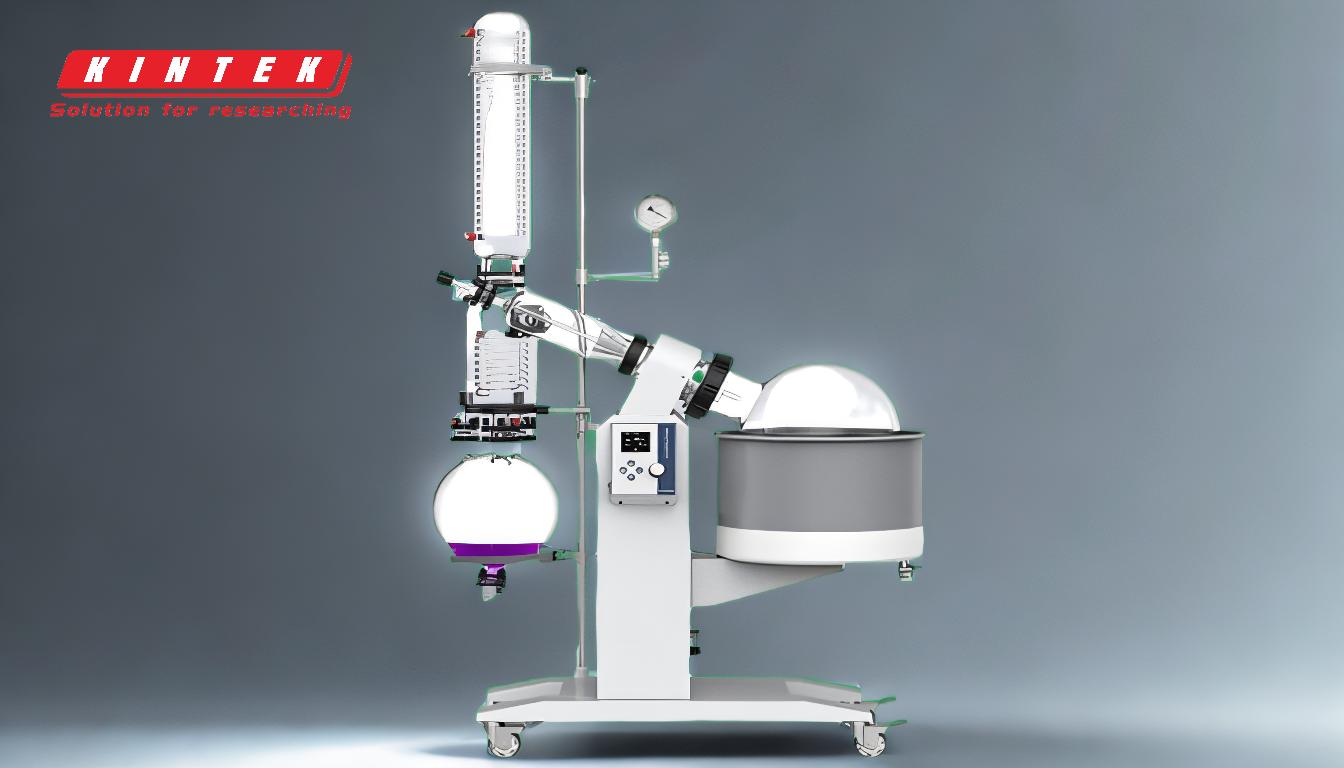Rotary evaporation is a widely used technique in chemical laboratories to remove solvents from samples efficiently and gently. It works by reducing the pressure inside the system, which lowers the boiling point of the solvent, allowing it to evaporate at lower temperatures. The sample is rotated to create a thin film on the inner walls of the flask, increasing the surface area for faster evaporation. The solvent vapor is then condensed and collected in a separate flask. This process is ideal for separating solvents from less volatile compounds, making it a key tool in organic, inorganic, and polymer chemistry.
Key Points Explained:

-
Principle of Rotary Evaporation:
- Rotary evaporation relies on two main principles: reduced pressure (vacuum) and increased surface area. By lowering the pressure, the boiling point of the solvent decreases, enabling evaporation at lower temperatures. This is particularly useful for heat-sensitive compounds.
- The rotation of the flask spreads the sample into a thin film, maximizing the surface area exposed to heat and vacuum. This accelerates the evaporation process.
-
Components of a Rotary Evaporator:
- Evaporation Flask: Holds the sample and rotates to create a thin film.
- Heated Water Bath: Provides controlled heating to the flask, ensuring even temperature distribution.
- Condenser: Cools the solvent vapor, converting it back into liquid form for collection.
- Vacuum Pump: Reduces the pressure inside the system, lowering the boiling point of the solvent.
- Receiving Flask: Collects the condensed solvent after it passes through the condenser.
- Bump Trap: Prevents the sample from splashing into the condenser during rapid evaporation.
-
Step-by-Step Process:
- Preparation: Ensure the water bath is heated, the condenser is cooled, and the solvent trap is empty. Secure the bump trap and sample flask using clamps.
- Rotation: Start the rotation at a moderate speed to create an even coating of the sample on the flask's inner walls.
- Vacuum Application: Gradually apply vacuum to reduce the pressure, observing condensation or bubbling as the solvent evaporates.
- Heating: Turn on the water bath to provide controlled heat, speeding up the evaporation process.
- Collection: The solvent vapor condenses in the condenser and collects in the receiving flask.
- Completion: Once all the solvent has evaporated, release the vacuum and stop the rotation.
-
Optimization Tips:
- Rotation Speed: Adjust the rotation speed based on the sample volume. Too fast can cause splashing, while too slow may reduce efficiency.
- Temperature Control: Maintain the water bath temperature slightly below the solvent's boiling point at reduced pressure to avoid overheating.
- Vacuum Adjustment: Gradually increase the vacuum to prevent bumping (sudden boiling) and ensure smooth evaporation.
- Flask Volume: Fill the evaporation flask to no more than 50% capacity to allow sufficient space for the thin film formation.
-
Applications:
- Rotary evaporation is used in various fields, including:
- Organic Chemistry: Removing solvents from reaction mixtures to isolate pure compounds.
- Pharmaceuticals: Concentrating drug formulations or purifying active ingredients.
- Food and Beverage: Extracting flavors or removing solvents from extracts.
- Polymers: Separating solvents from polymer solutions.
- Rotary evaporation is used in various fields, including:
-
Advantages:
- Efficiency: The thin film and reduced pressure allow for rapid solvent removal.
- Gentle Process: Lower temperatures minimize the risk of degrading heat-sensitive compounds.
- Scalability: Suitable for both small-scale laboratory work and larger industrial applications.
-
Challenges and Considerations:
- Bumping: Rapid boiling can cause the sample to splash into the condenser. Using a bump trap or reducing the vacuum can mitigate this.
- Solvent Compatibility: Ensure the solvent is compatible with the materials used in the rotary evaporator, such as the seals and tubing.
- Safety: Proper ventilation and handling of flammable solvents are essential to prevent accidents.
By understanding these key points, users can effectively operate a rotary evaporator and optimize the process for their specific needs.
Summary Table:
| Aspect | Details |
|---|---|
| Principle | Reduced pressure and increased surface area for gentle, efficient evaporation. |
| Key Components | Evaporation flask, heated water bath, condenser, vacuum pump, receiving flask, bump trap. |
| Process | Preparation → Rotation → Vacuum Application → Heating → Collection → Completion. |
| Optimization Tips | Adjust rotation speed, control temperature, manage vacuum, limit flask volume. |
| Applications | Organic chemistry, pharmaceuticals, food and beverage, polymer chemistry. |
| Advantages | High efficiency, gentle on heat-sensitive compounds, scalable for labs and industry. |
| Challenges | Bumping, solvent compatibility, and safety precautions. |
Need help optimizing your rotary evaporation process? Contact our experts today!











